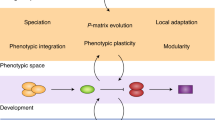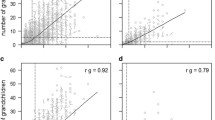Summary
Using a two-loci multiplicative model of resource allocation, we show how the existence of several levels of resource allocation may affect the sign of the genetic correlations between traits linked by trade-offs. Positive genetic correlations between components of fitness affected by genetic trade-offs may result from different amounts of genetic variability at the pleiotropic loci determining the allocation of resources. Thus positive genetic correlations may be obtained in the absence both of environmental variation and of differences between individuals in resource acquisition. Nevertheless, positive correlations between all components of fitness at the same time cannot be obtained without variability in the acquisition of resources.
Similar content being viewed by others
References
Atlan, A., Gouyon, P. H., Fournial, T., Pomente, D. and Couvet, D. (1991) Sex allocation in an hermaphroditic plant: the case of gynodioecy inThymus vulgaris L.J. Evol. Biol. (in press).
Barton, N. H. and Turelli, M. (1989) Evolutionary quantitative genetics: how little do we know?Ann. Rev. Genet. 23, 337–70.
Bell, G. (1980) The costs of reproduction and their consequences.Am. Nat. 116, 45–76.
Bell, G. (1984a) Measuring the cost of reproduction. I. The correlation structure of the life table of a plankton rotifer.Evolution 38, 300–13.
Bell, G. (1984b) Measuring the cost of reproduction. II. The correlation structure of the life tables of five freshwater invertebrates.Evolution 38, 314–26.
Bell, G. (1986) Reply to Reznicket al. Evolution 40, 1344–46.
Charlesworth, B. (1990) Optimization models, quantitative genetics, and mutation.Evolution 44, 520–38.
Devlin, B. (1989) Components of seed and pollen yield ofLobelia cardinalis: variation and correlations.Am. J. Bot. 76, 204–14.
Falconer, D. S. (1981)Introduction to quantitative genetics, 2nd edn Longman Scientific and Technical, Harlow, UK.
Giesel, J. T., Murphy, P. A. and Manlove, M. N. (1982). The influence of temperature on genetic interrelationships of life-history traits in a population ofDrosophila melanogaster: what tangled data sets we weave.Am. Nat. 119, 464–79.
Law, R. (1979a) The cost of reproduction in annual meadow grass.Am. Nat. 113, 3–16.
Law, R. (1979b) Optimal life histories under age-specific predation.Am. Nat. 114, 399–417.
Martinez, D. E. (1989) Positive genetic correlations between life-history traits in a marine Oligochaete. InAbstracts of the second congress of the European Society for Evolutionary Biology, Rome, 25–29 September. 42, Italy.
Pease, C. M. and Bull, J. J. (1988) A critique of methods for measuring life-history trade-offs.J. Evol. Biol. 1, 293–303.
Primack, R. B. (1979) Reproductive effort in annual and perennial species ofPlantago.Am. Nat. 114, 51–62.
Primack, R. B. and Antonovics, J. (1982) Experimental ecological genetics inPlantago. VII. Reproductive effort in populations ofP. lanceolata L.Evolution 36, 742–52.
Reznick, D. (1983) The structure of guppy life histories: the trade-off between growth and reproduction.Ecology 64, 862–73.
Reznick, D. (1985) Costs of reproduction: an evaluation of the empirical evidence.Oikos 44, 257–67.
Reznick, D. N., Perry, E. and Travis, J. (1986) Measuring the cost of reproduction: a comment on papers by Bell.Evolution 40, 1338–44.
Roff, D. A. and Mousseau, T. A. (1987) Quantitative genetics and fitness: lessons fromDrosophila.Heredity 58, 103–18.
Rose, M. R. and Charlesworth, B. (1981a) Genetics of life-history inDrosophila melanogaster. I. Sib analysis of adult females.Genetics 97, 173–86.
Rose, M. R. and Charlesworth, B. (1981b) Genetics of life-history inDrosophila melanogaster. II. Exploratory selection experiments.Genetics 97, 187–96.
Scheiner, S. M., Caplan, R. L. and Lyman, R. F. (1989) A search for trade-offs among life-history traits inDrosophila melanogaster.Evol. Ecol. 3, 51–63.
Thomson, J. D. and Barett, S. C. H. (1981) Temporal variation of gender inAralia hispida Vent. (Araliaceae).Evolution 35, 1094–1107.
Thomson, J. D., McKenna, M. A. and Cruzan, M. B. (1989) Temporal patterns of nectar and pollen production inAralia hispida: implications for reproductive success.Ecology 70, 1061–68.
Van Noordwijk, A. and De Jong, G. (1986) Acquisition and allocation of resources: their influence on variation in life-history tactics.Am. Nat. 128, 137–42.
Van Noordwijk, A. J. and Gebhardt, M. (1987) Reflections on the genetics of quantitative traits with continuous environmental variation. InGenetic constraints on adaptative evolution (V. Loeschcke, ed.) pp. 73–90. Springer-Verlag, Berlin, Germany
Williams, G. C. (1957) Pleiotropy, natural selection and the evolution of senescence.Evolution 11, 398–411.
Author information
Authors and Affiliations
Rights and permissions
About this article
Cite this article
de Laguerie, P., Olivieri, I., Atlan, A. et al. Analytic and simulation models predicting positive genetic correlations between traits linked by trade-offs. Evol Ecol 5, 361–369 (1991). https://doi.org/10.1007/BF02214153
Issue Date:
DOI: https://doi.org/10.1007/BF02214153




